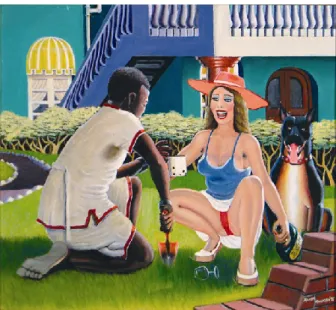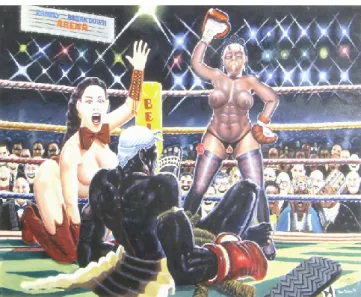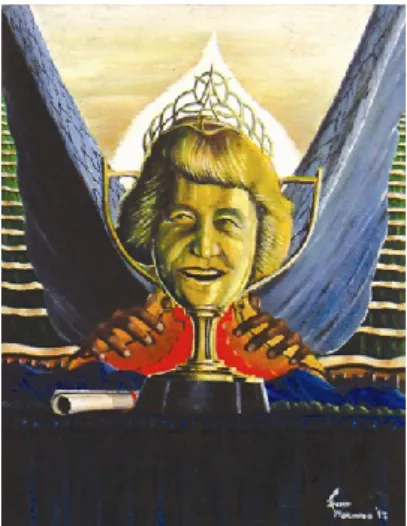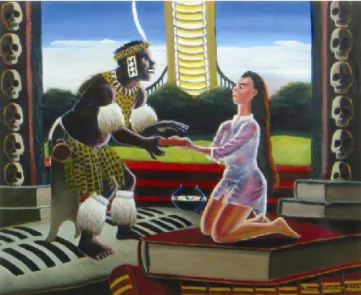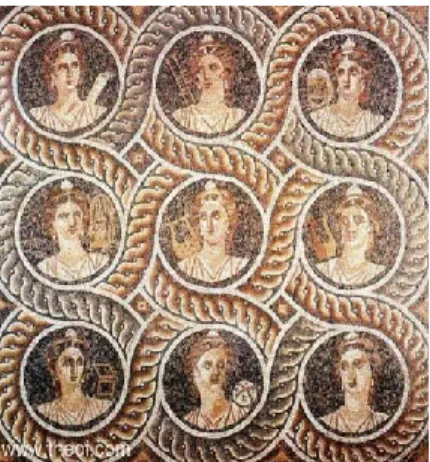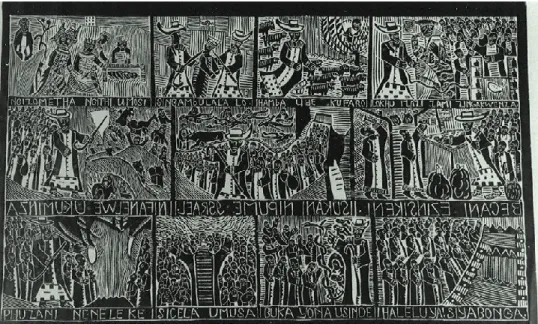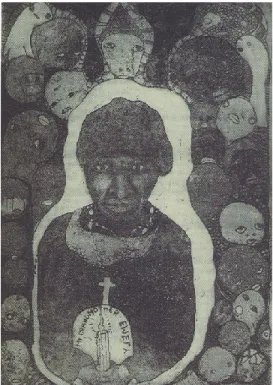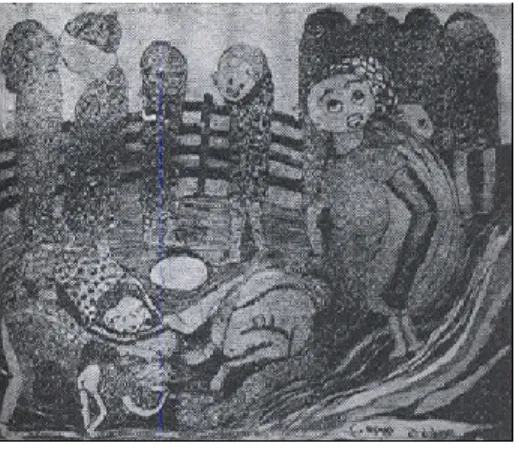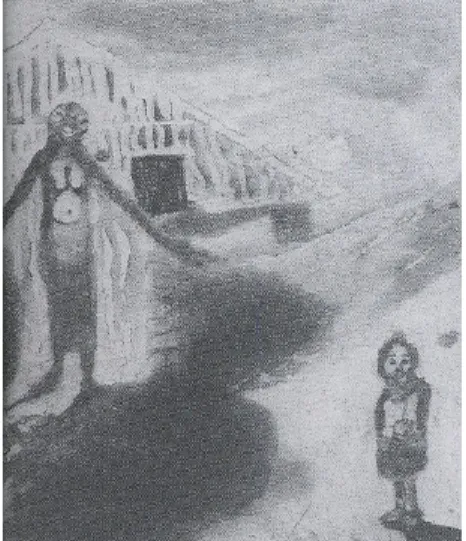Unless otherwise certified, this dissertation is the candidate's original work. It is argued that an artist like Trevor Makhoba can be considered a social commentator and “master of the oral genre” as he has translated this style into visual form. Each essay appeared as contextualizing texts, along with other essays, in post-1994 catalogs accompanying national traveling exhibitions of the individual artist's work.
Can one still draw on the source of original literature and interviews prior to the 1988 Neglected Tradition exhibition (see Historical, political and ethnic background of art in KZN) and expand them in the light of later post-modernist approaches and narrative (see more theoretical issues). This chapter draws on black peer readings of the late Trevor Makhoba's paintings, focusing on the artist's depictions of women, both black and white.
It is also argued that the artist's choice of sequential scenes in contrasting black and white linocuts, and, in works such as The Story of Moses, 1963, the inclusion of written Zulu biblical references, most likely derives from the artist's African roots. and not the influence of his Swedish teachers in Rorke's Drift. This argument means that I have, to some extent, disputed the assertions of Elizabeth Rankin and Philippa Hobbs in ―The prints of Azaria Mbatha: Memory in process‖ in the Azaria Mbatha Retrospective Exhibition (Durban Art Gallery, 1998) that Mbatha was forced to present himself as the leading African artist by his European audience's need for the mythical African. It is concluded that a lack of particularly cultural knowledge may result in a misreading of some of the deeper messages of this artist.
As in Mbatha's case, there is a political subversion present in the works that can only be appreciated in the light of postmodernism, the subtlety of which was missed in the more militant attitude of the anti-apartheid struggle politics of the time.
Chapter 5: Conclusion Endnotes
Considering cultural context and the implications of oral style on the interpretation and mediation of art in KwaZulu-Natal
This era of the 1930s-50s is known as the "period of Zulu cultural renaissance". (personal communication, Mwelela Cele, Durban, 2009) Tim Couzens writes in The New African: A study of the life and work of H.I.E. One could ask if it wasn't because this language is more expressive of the oral genre. Also significant in the literature on the "new Africans" is the recognition of the African penchant for debate, which is itself a characteristic of oral societies: Mdhuli comments regarding literary-debating societies:.
Some painters have developed a personal discourse "in response to their perception of their social role and to the conditions of the market" (Jewsiewicki 1991:149). If you look at the Zulu equivalent of the term "satire", it is the word umbhinqo.
Pondering ‘Africanness’ and ‘preferred form’
The artist sold through the African Art Centre, Durban which grew out of the liberal South African Institute for Race Relations. In the latter case, such an artist, especially if he works after 1994, may very well heed the call of the ‗African Renaissance' to return to African roots. The idea of the existence, both at present and even in the recent past, of an untainted indigenous pure African culture is patently false.
In light of the above, how does one take such comments as those of authors Rankin and Hobbs (1998) regarding Mbatha's mythical proportions. In relation to this, it is instructive to review some of the narrative techniques or 'preferred forms' used in the Zulu language.
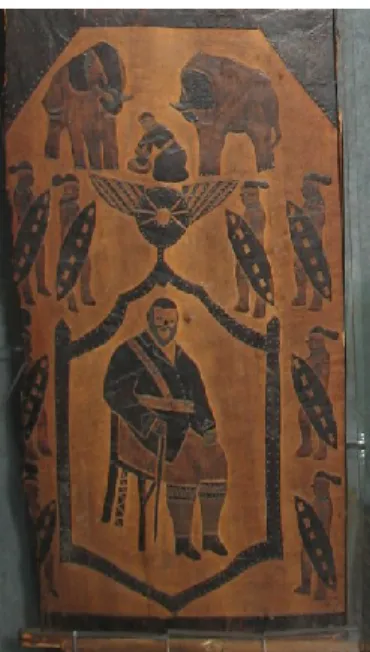
Historical, political and ethnic background of art in KwaZulu-Natal
The index was modeled after the Killie Campbell Oral History Project in 1978 at the Campbell Collections. These lands are found on the borders of old Natal south of the Tugela River, while the Zulus are found in the former Zululand across that river. The basis of traditional culture, as practiced in these homelands, is a patrilineal, primarily pastoral people who believe in the influence of the spirits of their ancestors on the lives of their descendants.
The missions were not only the beginning of education in the province, the United Christian Church of the American Board was 'home' for many of the. Traditional lifestyle and religion of the ancestors versus missionary introduced orthodox Christianity or Zionist African Christian synchronism.
Broader theoretical framework
Post-modernism in museums is concerned with the repatriation of sacred artefacts, community engagement, the 'Voice' or narrative of the individual artist and the recapture of cultures. In the case of this thesis there is the cultural narrative, local knowledge and IKS as well as the life history and 'Voice' of the artists' own narratives. Narrative therapy owes much to postmodernism and 'Foucaultian' thinking as in Michael Foucault, The hermeneutics of the subject: lectures at the Collège de France, 1981-82 (Palgrave-Macmillan, 2005).
It was this experience that caused Grossert to go against the accepted views of 'High Art' at the time and include graphic art and painting in the syllabus of the Ndaleni Art School in KwaZulu-Natal. Bronislaw Malinowski's A Diary in the Strict Sense of the Term made established accounts of the way anthropologists work quite implausible.
There are also more formal oral interviews which form part of the Artist Index at Campbell Collections, UKZN. In particular the staff of the Center for Visual Arts, UKZN, Pietermaritzburg, with lecturers Juliette Leeb-du Toit, Juliet Armstrong and Ian Calder, and the University of the Witwatersrand Galleries, current and former Johannesburg staff, Karel Nel, Fiona Rankin-Smith, Elizabeth Rankin, Philippa Hobbs and Rayda Becker . All these projects were led by Professor Yonah Seleti, who later moved to the Department of Science and Technology's Indigenous Knowledge Division, based in Pretoria/Tshwane.
It is for the same reasons that my original essays contain many footnotes, acknowledgments and annotations, as I considered it a matter of personal ethics as urgent as that of showing respect for cultural values and the personality of the artists. Arts and crafts in education: a critical review of the development of arts and crafts education in Bantu schools in Natal, with particular reference to the period 1948-1962 Pietermaritzburg, Shuter and Shooter. One of the earliest works that dealt with both African graphic art and traditional crafts was Anitra Nettleton and David Hammond-Tooke African Art in Southern Africa: From Tradition to Township (A.D. Donker, 1989).
In terms of my work, I made available the information contained in the Artist Index, the documentation of the African Art Centre, Durban and the student files of the Ndaleni Art School, all housed in the Africana library. As stated, all of this writing derives specifically from my work as Curator (more precisely Senior Museologist) at the Campbell Collections of the University of KwaZulu-Natal. The main contemporary emphasis in US museums is on community outreach and "Voice", itself a shift from the elite curator/academy of galleries/museums of earlier times.
My education and experience made me well aware of the cultural roots of much of the sculptural and graphic artwork by African artists. Therefore, my essay contributions center on the disciplinary intersection between art and ethnography; dissemination of original cultural cosmology/worldview, aesthetics, craft techniques, cultural changes and reflections on the artist's own temperament/individuality. To this can be added the question of the oral genre in its various aspects, made in the reformulation of essays into chapters, as well as the attempt to see how this affects the choice of the preferred aesthetic form.
Essay 1
Trevor Makhoba and reflections on a distinctive African Genre
Essay 2
Re-reading black South African history through the works of Azaria Mbatha
Essay 3
The graphic works of Cyprian Shilakoe: reflections on a cosmology informed by a unique combination of temperament and culture
Conclusion
I also argue that many of the works with a biblical theme are veiled political commentary on the nature of man's (species) existence in the apartheid decades. Africanness 'that does not only appeal to a Western audience, but rather arises from the oral versus literate mentality of the native cultures. This is the early Zulu spelling that has been retained except for the insertion of an h in the Oral Interview Project of the famous rebel's descendants in 2004.
The Nazi regime rejected such ideas with the service of the Holocaust. 21 Thorpe painted the work “Zungu Flight” [JT223], which shows Zungu and his wife sitting together on a plane. 24 The Embo-Mkhize people believe that historically they are not of the same Nguni lineage as the Zulus.
It provides an understanding of the relationship between the Zulu oral narrative style and the characteristic artistic style under discussion. In 2008, a number of these peoples presented to the Nhlapo Commission (commissioned by the Government to consider the position of traditional clan heads) to be recognized as independent from the Zulus with a "kingdom" status. Again Mbatha looked closely and asked if he could get copies especially of the Zulu monarchs.
68 Isaan lamaan dhiirota gosa BaKoni kan BaPedi ykn gosa Sotho Kaabaa naannoo Bosbokrand Mapumalanga turan. Kunis balaa hawaasummaan dhabamsiisuu irraa kan ka’e ta’uu hin oolu. personal communication Afaan Oromoo fi Jechoota Dinqisiiso Afaan Oromoo. 89 Thefifi ykn sefifi (‘ho’a’), inni lammaffaan kan istaandaardii Sotho Kaabaa yoo ta’u inni duraa immoo jecha BaKoni/Kgaga ta’e.
Bibliography
- Introduction
- Essay 1. Trevor Makhoba and reflections on a uniquely African Genre
- Essay 2. Re-reading black South African history through the works of Azaria Mbatha
- Essay 3. The graphic works of Cyprian Shilakoe: reflections on a cosmology informed by a unique combination of temperament and culture
Painting in Zaire: From the Invention of the West to the Representation of Social Self. Eds.), Freedom sown in blood: memories of the Impi Yamakhanda an indigenous knowledge system perspective Thoyandou, Ditlou Publishers. The prints of Azaria Mbatha: memory in process In Addleson, J. (Ed.), Azaria Mbatha Retrospective Exhibition catalogue.
Reviews; reaction; revision : approaches to composition for a new South Africa In Proceedings of the South African Art Historians Association. South African Museum Association Professional Standards and Transformation Indicators SAMA in collaboration with the Transformation training program of the Department of Art and Culture. Art history and mythmaking in South Africa: the example of Azaria Mbatha Azaria Mbatha exhibition.
In Hammond-Tooke, D.(Ed.), The Bantu-Speaking Peoples of Southern Africa London, Routledge & Kegan Paul. The life of Marcel Jousse and the development of his theory of oral style in. Reviews: Expanding the Narrative of South African Art - Campbell Smith Cape Town Collection, Iziko Museums.
Report of the Umpumulo consultation on the healing ministry of the church Mapumulo, Missiological Institute. African roots in the work of Azaria Mbatha In Addleson, J. (Ed.), Azaria Mbatha Retrospective Exhibition catalogue.
